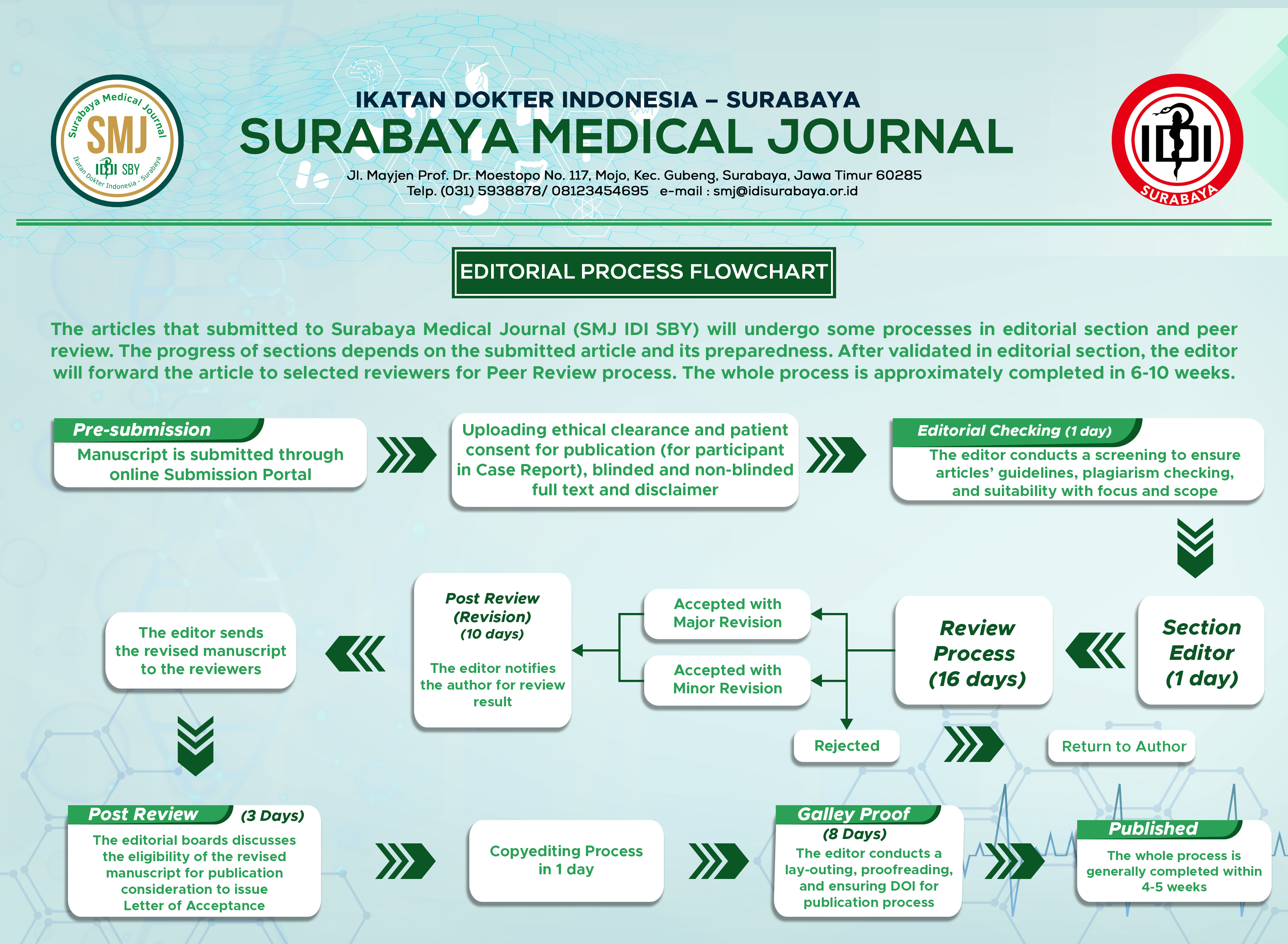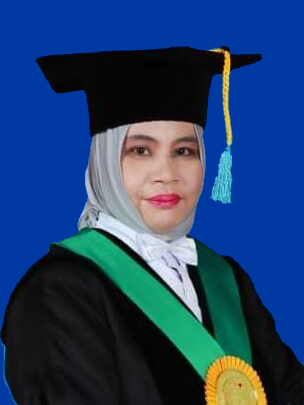Announcements Focus and Scope Publication Ethics Peer Review Process Article Processing Charge Open Access Statement Plagiarism
About the Journal
Surabaya Medical Journal is an official published by Ikatan Dokter Indonesia Surabaya focusing on scientific journal devoted to research and development publications in the medical field. Specialties featured in the Surabaya Medical Journal include all aspects in medicine and health sciences. Articles can be in the form of original research report, case report/case series, image article, scoping review, systematic review, meta-analysis, randomized clinical trial and community service report/viewpoint/opinion.
FOCUS AND SCOPE
Surabaya Medical Journal covers basic and clinical medicine in humans with health related concerns in community. Due to our various audiences' background and needs, our journal focuses on the updated issue in individual and community - related health issues, health services, health policies, health education, medical management, nutrition and development, but also several other topics can be considered for publication including child health and tropical diseases, surgery, emergencies and critical conditions.
GUIDELINES FOR AUTHOR
Surabaya Medical Journal is an official published by Ikatan Dokter Indonesia Surabaya focusing on scientific journal devoted to research and development publications in the medical field. Specialties featured in the Surabaya Medical Journal include all aspects in medicine and health sciences. Articles can be in the form of original research report, case report/case series, image article, scoping review, systematic review, meta-analysis, randomized clinical trial and community service report/viewpoint/opinion. Submitted manuscripts are considered for publication with the condition that they have not been published or being submitted for publication elsewhere. The manuscript must be written in American-English with proper grammar. The use of grammar-checker applications is mandatory for any non-native authors. The manuscript should be written by the structure as in the Document Template. The Document Template includes a Author's Declaration & CTA form that the manuscript does not contain fabricated, falsified, and plagiarized text and/ or data, that the manuscript has never been published before and is not under consideration for publication by another party and that all authors have agreed on the final form of the manuscript. All authors involved in making the manuscript must agree to the statement sheet outlined by the International Committee of Medical Journal Editors (ICMJE).
The Editorial Board reserves the right to edit all articles in aspects of style, format and clarity. Authors may be required to revise their manuscripts for reasons of any aspect. Manuscript with excessive errors in any aspects may be returned to the author for revising or may be rejected. All manuscripts will be subjected to editorial review prior to a double-blind peer-review by at least two independent reviewers. The author(s) cannot withdraw any submitted manuscript that has been sent to the peer reviewers.
All types of manuscript must consist of:
- Title, must be concise, specific and informative. The title must consist of no more than 30 words, written on the top line with bold Times New Roman font size 11, uppercase and left-margin.
2. Running title(other and shorter version of the full title), corresponding author and address must be written accordingly (see Document Template).
3. Authors' names should be written in full and should not include any academic titles or ranks. Additionally at least one of the authors must provide their ORCID ID, and a link to the ORCID IDlogo should be embedded after their name in the author list.
4. Abstract must be written in English in one paragraph with no more than 300 words. Abstract of original research report, randomized controlled trial, scoping review, systematic review or meta-analysis must contain background, objective, materials and methods, results, and conclusion, while the abstract of case series must contain background, objective, cases, discussion, and conclusion.
5. Keywords should consist of 3-6 words and/ or phrases, written below the abstract as seen in the template, in English, started with a capital letter (sentence case), separated with semicolon, and without an ending point. The keywords must contain at least one keyword of Sustainable Development Goals (SDGs). Authors can use terms present in Medical Subject Headings (MeSH) as the keywords.
6. Corresponding author is responsible for handling all correspondence with the Editorial Board during both the pre- and post-publication process of the manuscript.
7. Highlights of the manuscript should consist of minimally two key points representing the novel contributions of the study and must not be the copy-paste and/ or repetition of sentences of any other parts of the manuscript. The highlights should be written using numbers before the introduction under the subheading “Highlights”.
8. Introduction should provide the rationale for the study and explain the main problem the research seeks to address. It should also establish a gap in current knowledge and convince readers that the study has addressed that gap. This section should not exceed four paragraphs without subheadings.
9. Materials and Methods of the manuscript should provide a detailed explanation of the research design, settings, time frame, variables, population, samples, sampling methods, instruments, data analyses and ethical clearance. This section may be divided into subsections if multiple methods are used.
10. Results should describe the significance of the findings in a logical stream of thought. The most important part of the manuscript is found in this section. The total number of tables and figures is advised to be no more than five.
11. Figures (including graphs, diagrams, charts, drawings, and photographs) should be cited in ascending Arabic numerals according to their first appearance in the manuscript. They should be submitted in JPEG format, not smaller than 300 dpi and should not be submitted in separate files. Each figure should be labeled with Arabic numerals in order, followed by a brief descriptive title and the title of each figure should be written center-aligned at the bottom of the figure, in normal Times New Roman, font size 9.
12. Tables should be cited in ascending Arabic numerals according to their first appearance in the manuscript. Each table should be labeled with Arabic numerals in order, followed by a brief descriptive title, centered above the table. Tables should not be submitted in separate files. Total number of tables and figures should be limited, advisably no more than five, and the title of each table should be written center-aligned at the top of the table, in normal Times New Roman, font size 9. Text within tables should be written in 1 space, normal Times New Roman font size 9 or less.
13. Discussion should explain the results of the study and how they answered the research problem. Differences and similarities with previous studies should be elaborated. The limitations of the study should also be mentioned in this section, along with possibilities for developing further studies. The authors should not repeat the results in this section.
14. Strength and limitations, the authors should describe the strength of the study that may include the findings, the novelty of the topic and methodology, and the contribution of the study. In addition, the limitations of the study should also be described that may include the lack of access to information or resources, the limited time of the study, and the size of the population. Suggestions for further studies can also be included in this part.
15. Conclusion should provide the main idea or results of your article, do not copy-paste your materials and methods or results here. It must answer the research objectives and be based on the results and discussion previously explained. Suggestions for further research may be included.
16. Acknowledgment must have been consented by all parties acknowledged, do not put any identity of patients in the case report article here, along with a brief description of their contributions.
17. Conflict of Interest must accompany manuscripts submitted to Surabaya Medical Journal. A conflicts of interest disclosure statement or declaration should state that the authors have no conflicts of interest to declare. If there is no conflict of interest, please state “None.”
18. Ethical considerations should include the research ethics certification number, date, and the agency that provided it must be written. Any work on human beings must include a letter of approval for publication from the participant and his/her legal guardian.
19. Funding disclosure should state how the research was funded, including grant numbers if applicable. Write down the institution, city, and country. If there are no fundings received, please state “None.”
20. Author contribution should be declared in accordance with the ICMJE guidelines for authors. For example, AB carried out …, BC contributed …, and DE analyzed …. The contribution of each author should be in line with their respective evidence in the research. All authors should be listed in this section, along with their contributions to the research process, including preparation, data gathering and analysis, drafting, and approval for publication of the manuscript.
21. References should be numbered consecutively in the order they appear in the text, according to Vancouver style. References should use the most updated and relevant references from the last 10 years of the submission date. Use the original article as much as possible. References are advisably not to exceed 30 in number but not less than 20. Reference management software, such as Mendeley®, Zotero®, and EndNote®, should be used to write citations and references. All words in Latin must be written in italics. The use of abbreviations is generally agreed upon, and an extension must be given in the first mention of the abbreviation. Decimal numbers are marked with points (.).
TYPES OF MANUSCRIPTS
The SMJ accepts original research report, case report/case series/image article, scoping/systematic review, meta-analysis, randomized clinical trial, and community service report/viewpoint/opinion. Generally, original research reports, case reports/case series/image articles, scoping/systematic review, meta-analysis, randomized clinical trials, and community service report/viewpoint/opinion should not exceed 12 pages (3,500-5,000 words). The article should be written in English.
PUBLICATION ETHICS
Surabaya Medical Journal is a scientific peer-reviewed journal covering all areas in medicine including basic and clinical medicine for humans. It also focuses on healthcare, education, and entrepreneurship in medicine, as well as social health-related problems. The following statement clarifies the ethical behaviour of all parties involved in publishing an article in this journal, including the author, editor, reviewer, and publisher (Surabaya Medical Journal managed by Ikatan Dokter Indonesia Surabaya).
Surabaya Medical Journal adapted guidelines from the Committee on Publication Ethics (COPE) Best Practice Guidelines and the International Committee for Medical Journal Editors (ICMJE) for publication ethics and publication misconduct. All the research involving human subjects (material or data) must be equipped with ethical standards in accordance with the Declaration of Helsinki and must have been approved by an Ethics Committee, and stated in the manuscript, including the statement of ethical consideration, the name of Ethics Committee, the number of ethics certificate, date and duration of approval.
PEER REVIEW PROCESS
All manuscripts submitted to this journal must be in line with this journal’s focus and scope, as well as author guidelines. The submitted manuscripts must address scientific merit or novelty appropriate to the focus and scope. All manuscripts must be free from plagiarized content. All authors are suggested to use plagiarism detection software to conduct similarity checking. Editors will screen the submitted manuscript's content using Turnitin with minimal acceptance of a similarity rate of less than 20%.
All manuscripts submitted to this journal will be double-blind reviewed by at least 2 (two) or more peer-reviewers. This means both parties are blinded to each other to maintain objectivity. The reviewers must follow the peer-reviewers form and give valuable scientific comments thus improving the manuscript's content. The editorial board will make the final decision on the acceptance of all manuscripts before publication. Decisions regarding the publication of accepted articles, including article sequence, will be made by the Editor in Chief, with help from all editors. This decision will depend on the sequence of accepted dates and authors' geographical distribution, as well as thematic issues and conditional circumstances.

ONLINE SUBMISSIONS
The journal requires an online submission. The author needs to be registered on the journal website.
Already have a username/password for SMJ?
GO TO LOGIN
Need a username/password?
GO TO REGISTRATION
Registration and login are required to submit items online and to check the status of current submissions.
REVISED SUBMISSIONS
Authors are requested to submit revisions within one month for all reviewing processes (i.e., rapid decision or the review stage). If not, the submission will be removed from the editorial system and needs to be submitted as a new submission.
SUBMISSION PREPARATION CHECKLIST
As part of the submission process, authors are required to check off their submission's compliance with all of the following items, and submissions may be returned to authors that do not adhere to these guidelines.
- The text adheres to the stylistic and bibliographic requirements outlined in the Author Guidelines, which is found in About the Journal.
- The submission has not been previously published, nor is it before another journal for consideration (or an explanation has been provided in Comments to the Editor).
- The submission file is in OpenOffice, Microsoft Word, RTF, or WordPerfect document file format.
COPYRIGHT NOTICE
The copyright of the received article shall be assigned to the journal as the publisher of the journal. The intended copyright includes the right to publish the article in various forms (including reprints). The journal maintains the publishing rights to the published articles.
This work is licensed under a Creative Commons Attribution 4.0 International License.
ARTICLE PROCESSING CHARGE
Surabaya Medical Journal does not apply any submission or publication fees. Two copies of the printed version will be provided and sent to the corresponding author of the published article.
OPEN ACCESS STATEMENT
This journal provides immediate open access to its content on the principle that making research freely available to the public supports a greater global exchange of knowledge in medicine.
This journal (p-ISSN:2986-2469 e-ISSN:2986-7584) is licensed under Creative Commons Attribution 4.0 International License.
PLAGIARISM CHECK
All manuscripts must be free from plagiarism in any form. All authors are suggested to use plagiarism detection software to conduct similarity checking. Editors will screen the submitted manuscript's content using Turnitin with minimal acceptance of a similarity rate of less than 20%.













